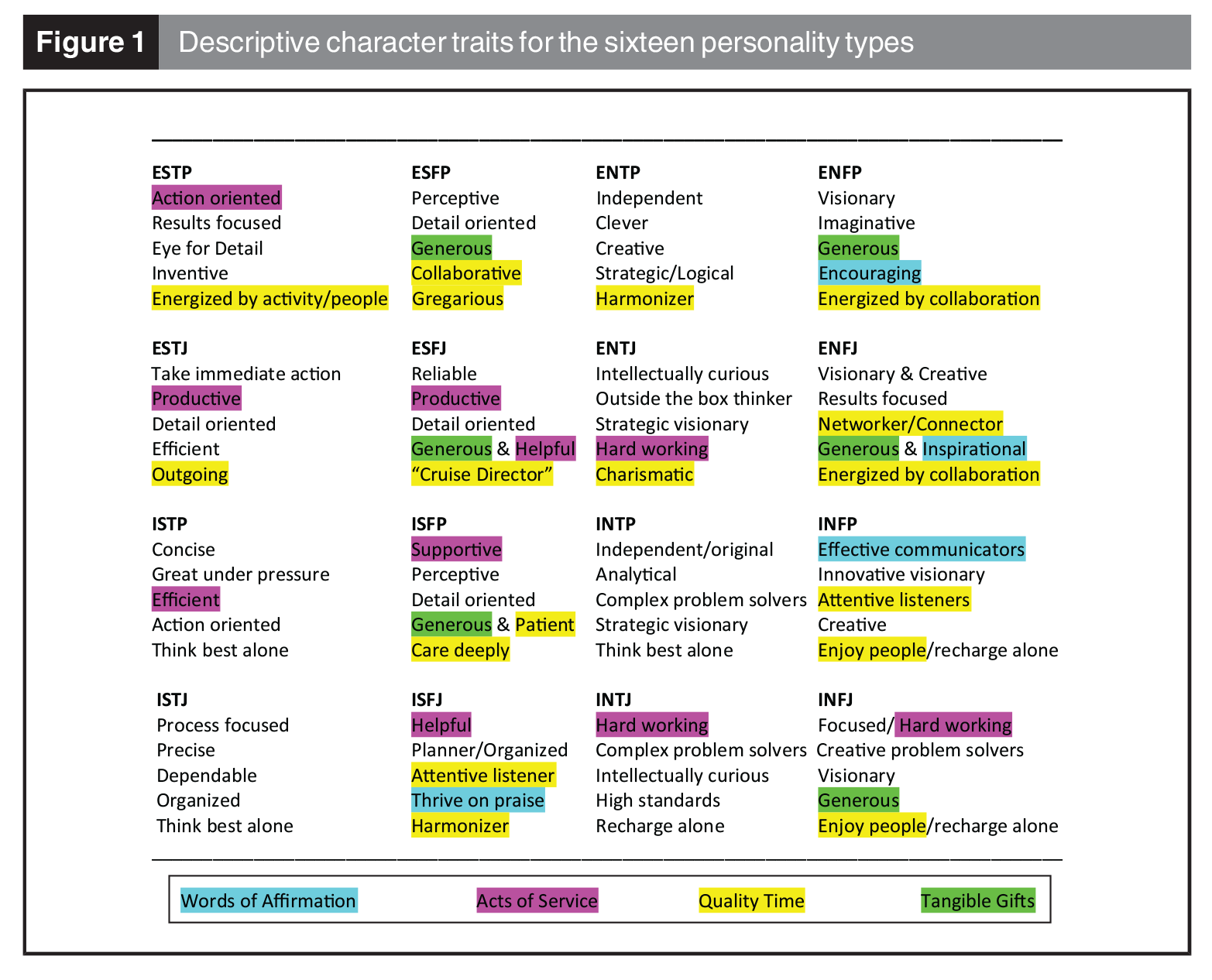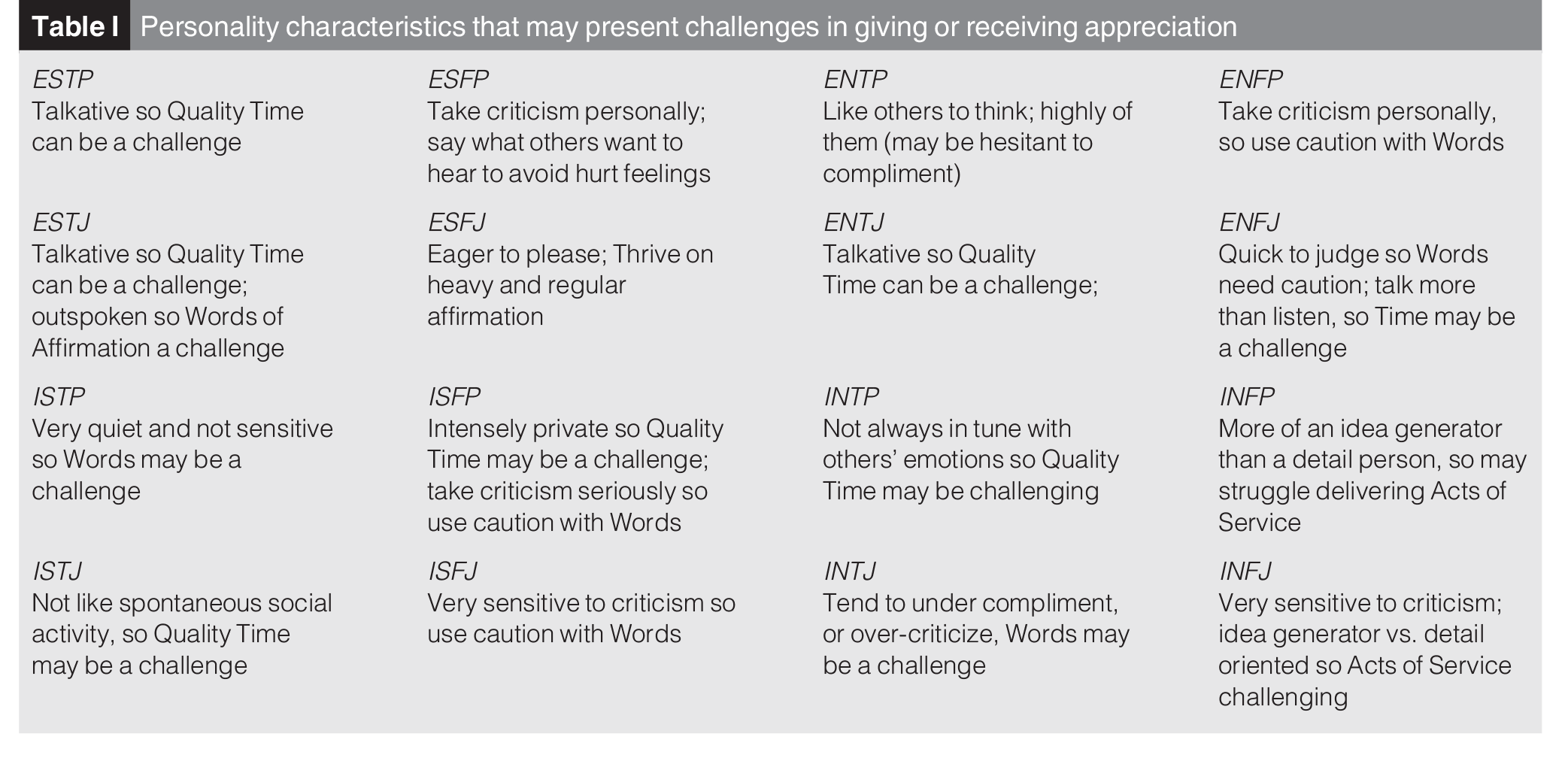How Personality Type and Languages of Appreciation Interrelate
People often comment, “I wonder how the Myers-Briggs and the 5 Languages of Appreciation might be related?” We wondered about this, too, and so we conducted a research study to discover the answer.
Categorizing people into distinct personality types has been an area of interest for millennia and numerous approaches to finding various dimensions of personality characteristics have been utilized. The Myers-Briggs Type Indicator® is a well-known approach to assessing personality which divides personality characteristics into four continua:
- Extroversion / Introversion
- Extroversion (E) – people oriented, talkative, outgoing
- Introversion (I) – inward focus, reflective, pensive, task oriented
- Sensing / Intuition
- Sensing (S) – reality based, practical, literal
- INtuition (N) – imaginative, big picture, ideas & concepts
- Thinking / Feeling
- Thinking (T) – logic, value justice
- Feeling (F) – personal values & how things impact others/empathetic
- Judging / Perceiving
- Judging (J) – structured, predictable
- Perceiving (P) – keep options open, spontaneous
These are then combined to create 16 personality types (e.g., ENFP) used to help identify styles of interacting with others.
We conducted a research study with 300 employees to explore the relationship between Myers-Briggs personality types and the 5 languages of appreciation. The TypeCoach Verifier is an interactive approach which was used to help participants determine preferences on the 4 Myers-Briggs dimensions. The Motivating By Appreciation (MBA) Inventory identifies the languages of appreciation that employees prefer to be shown appreciation by their colleagues.
The interrelatedness of the Myers-Briggs personality types and individuals’ preferred language of appreciation was investigated, and, as predicted, the two were found to be independent constructs. This is consistent with prior related research finding no relationship between employees’ languages of appreciation and their personality type as assessed by the DISC. Thus, it appears that personality style and preferred ways of receiving appreciation appear to be independent.
How the Myers-Briggs and 5 Languages of Appreciation Can Be Used Together
Despite the fact that these two constructs are independent, each assessment provides additional valuable information which the other tool does not. Individuals’ personality type (style of relating to others and completing tasks) is helpful to know in building teams to facilitate working together effectively. Similarly, communicating appreciation to colleagues in the ways most meaningful to them helps create a more supportive and encouraging workplace, which facilitates employee engagement.
More importantly, the information given by each assessment can also enhance the applicability of the results from both tools. For example, while the MBA Inventory identifies what kind of act of appreciation an employee values (spending time together, a word of encouragement, etc.), one’s personality type provides information about how an employee prefers feedback – an introvert may prefer a private conversation, while an extrovert may prefer public praise.
Additionally, an individual’s personality type provides clues for what they want to be shown appreciation. See Figure 1 below for practical examples of characteristics highly valued by each personality type. Including mention of these within the context of a colleague’s preferred language of appreciation would make it even more personally relevant. For example, an INTJ whose primary language of appreciation is Quality Time might feel especially appreciated when the supervisor says, “Josh, let’s go out to lunch to celebrate your hard work and clever idea that resolved that issue and saved the company thousands of dollars.”
Further, there are certain characteristics within each Myers-Briggs personality that may present a challenge to either giving or receiving appreciation (See Table1). For example, people who are talkative need to make extra efforts to listen attentively to people whose primary language is Quality Time, or else the lack of focused attention will leave the individual feeling unappreciated.
Summary
Our research found that one’s personality style and preferred ways of being shown appreciation are independent – you cannot predict one from the other. However, combining the knowledge of how employees prefer to be shown appreciation along with the characteristics associated with their personality type will provide the most effective way of encouraging and supporting those with whom you work, and will be the most successful in creating a positive and effective workplace. As is often the case in life, “two is better than one!”
Tags: 5 Languages, appreciation, DISC, MBA Inventory, MBTI, Myers-Briggs, Personality, Personality Type, recognitionCategories 5 Languages of Appreciation, Communication, Employee engagement, MBA Inventory




3 Comments
This so well nicely explained. I hope more and more get access to this information and also the resources for that. Thank your for writing this.
Thank you Kanika.
Wow this is great stuff! Altho, I still think it’s hard to pinpoint 1 for my hubby of almost 20 yrs! ESTJ is almost him to a T , yet it shows quality time as his preferred love language & I’m sure this doesn’t speak to him as much as words of affirmation/praise/compliments &/or acts of service! So I’m not convinced yet lol – also I feel we aren’t robotic – most of us humans are made up of many differing even s/times opposing traits & childhood or teen or adult experiences which affect us & change ourselves each year / stage…but it’s great to see the info graphics 🙂 thx!